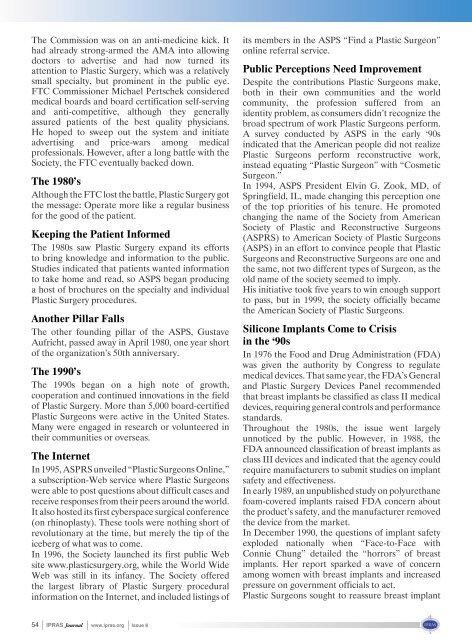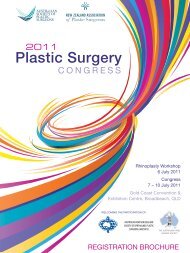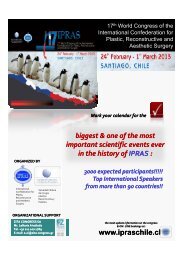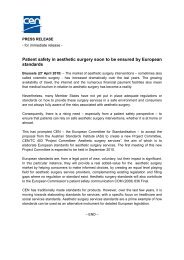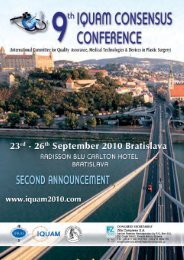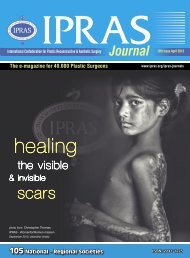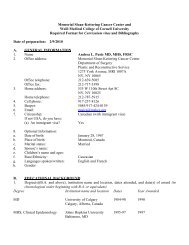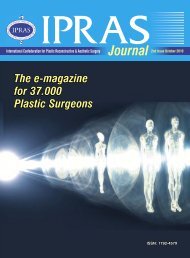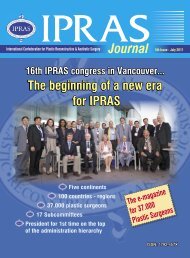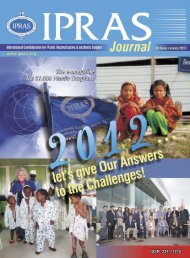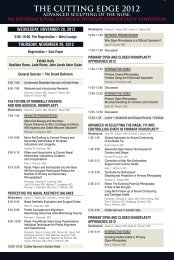Download pdf file - IPRAS
Download pdf file - IPRAS
Download pdf file - IPRAS
- No tags were found...
You also want an ePaper? Increase the reach of your titles
YUMPU automatically turns print PDFs into web optimized ePapers that Google loves.
The Commission was on an anti-medicine kick. Ithad already strong-armed the AMA into allowingdoctors to advertise and had now turned itsattention to Plastic Surgery, which was a relativelysmall specialty, but prominent in the public eye.FTC Commissioner Michael Pertschek consideredmedical boards and board certification self-servingand anti-competitive, although they generallyassured patients of the best quality physicians.He hoped to sweep out the system and initiateadvertising and price-wars among medicalprofessionals. However, after a long battle with theSociety, the FTC eventually backed down.The 1980’sAlthough the FTC lost the battle, Plastic Surgery gotthe message: Operate more like a regular businessfor the good of the patient.Keeping the Patient InformedThe 1980s saw Plastic Surgery expand its effortsto bring knowledge and information to the public.Studies indicated that patients wanted informationto take home and read, so ASPS began producinga host of brochures on the specialty and individualPlastic Surgery procedures.Another Pillar FallsThe other founding pillar of the ASPS, GustaveAufricht, passed away in April 1980, one year shortof the organization’s 50th anniversary.The 1990’sThe 1990s began on a high note of growth,cooperation and continued innovations in the fieldof Plastic Surgery. More than 5,000 board-certifiedPlastic Surgeons were active in the United States.Many were engaged in research or volunteered intheir communities or overseas.The InternetIn 1995, ASPRS unveiled “Plastic Surgeons Online,”a subscription-Web service where Plastic Surgeonswere able to post questions about difficult cases andreceive responses from their peers around the world.It also hosted its first cyberspace surgical conference(on rhinoplasty). These tools were nothing short ofrevolutionary at the time, but merely the tip of theiceberg of what was to come.In 1996, the Society launched its first public Website www.plasticsurgery.org, while the World WideWeb was still in its infancy. The Society offeredthe largest library of Plastic Surgery proceduralinformation on the Internet, and included listings ofits members in the ASPS “Find a Plastic Surgeon”online referral service.Public Perceptions Need ImprovementDespite the contributions Plastic Surgeons make,both in their own communities and the worldcommunity, the profession suffered from anidentity problem, as consumers didn’t recognize thebroad spectrum of work Plastic Surgeons perform.A survey conducted by ASPS in the early ‘90sindicated that the American people did not realizePlastic Surgeons perform reconstructive work,instead equating “Plastic Surgeon” with “CosmeticSurgeon.”In 1994, ASPS President Elvin G. Zook, MD, ofSpringfield, IL, made changing this perception oneof the top priorities of his tenure. He promotedchanging the name of the Society from AmericanSociety of Plastic and Reconstructive Surgeons(ASPRS) to American Society of Plastic Surgeons(ASPS) in an effort to convince people that PlasticSurgeons and Reconstructive Surgeons are one andthe same, not two different types of Surgeon, as theold name of the society seemed to imply.His initiative took five years to win enough supportto pass, but in 1999, the society officially becamethe American Society of Plastic Surgeons.Silicone Implants Come to Crisisin the ‘90sIn 1976 the Food and Drug Administration (FDA)was given the authority by Congress to regulatemedical devices. That same year, the FDA’s Generaland Plastic Surgery Devices Panel recommendedthat breast implants be classified as class II medicaldevices, requiring general controls and performancestandards.Throughout the 1980s, the issue went largelyunnoticed by the public. However, in 1988, theFDA announced classification of breast implants asclass III devices and indicated that the agency couldrequire manufacturers to submit studies on implantsafety and effectiveness.In early 1989, an unpublished study on polyurethanefoam-covered implants raised FDA concern aboutthe product’s safety, and the manufacturer removedthe device from the market.In December 1990, the questions of implant safetyexploded nationally when “Face-to-Face withConnie Chung” detailed the “horrors” of breastimplants. Her report sparked a wave of concernamong women with breast implants and increasedpressure on government officials to act.Plastic Surgeons sought to reassure breast implant54 <strong>IPRAS</strong> Journal www.ipras.org Issue 6


